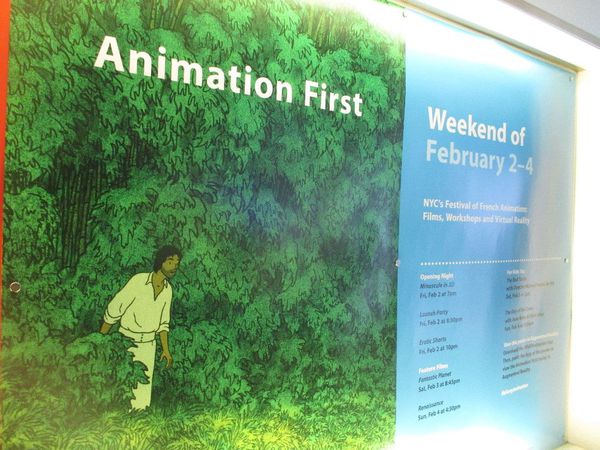 |
| Michaël Dudok de Wit on Isao Takahata of Studio Ghibli: "He's very much into symbolism, metaphors and the subtle emotions." Photo: Anne-Katrin Titze |
The French Institute Alliance Française in New York in their latest CinéSalon series is honouring actresses who have won the César Award. Catherine Deneuve in François Truffaut's 10-César award-winning The Last Metro (Le Dernier Métro - introduced by Anne-Katrin Titze on February 13 at 4:00pm); Sandrine Bonnaire in Agnès Varda's Vagabond (Sans Toit Ni Loi), and Isabelle Huppert (Oscar-nominated for her performance) in Paul Verhoeven's Elle are the upcoming Best Actress: A César-Winner Showdown films to be shown.
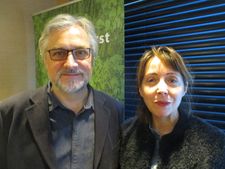 |
| Michaël Dudok de Wit with Anne-Katrin Titze on Lafcadio Hearn's Kwaidan: "It's basically fairy tales and ghost stories." Photo: Natascha Bodemann |
Michaël Dudok de Wit's (César and Oscar-nominated and Cannes Film Festival Un Certain Regard Special Jury Prize winner) debut feature The Red Turtle, co-written with Lady Chatterley director Pascale Ferran and co-produced by Toshio Suzuki of Studio Ghibli (Hayao Miyazaki's The Wind Rises and Isao Takahata's The Tale Of The Princess Kaguya) was highlighted this past weekend in Animation First. In the first installment of my conversation with the Oscar-winning director (Father And Daughter) he spoke about the influence of Miyazaki's Totoro, myths and fairy tales, seal maidens, Lafcadio Hearn's Kwaidan, visiting Studio Ghibli and looking forward to meeting Ushiko, the feline star of Mami Sunada's The Kingdom Of Dreams And Madness.
In The Red Turtle, a man is washed ashore onto a deserted island out of a stormy sea. He attempts to leave by building a raft with the bamboo he finds strewn in the forest. Over and over again he fails to accomplish his goal due to an attack from below. His third effort, this time one with a sealskin sail, is toppled and a large red turtle with kind eyes comes to the surface. You can feel the weather as the luminosity sets the tone. The exquisite shadows in particular tell the tale. Little crabs and baby turtles in good Ghibli tradition carry light and darkness within them. Nature is stunning and sublime in these images.
Could furtive creatures be lurking in the brush? Or are they lodged in a man's heart? Scenes of entrapment and dream sequences map out the formation of the tale. A pool surrounded by high rocks triggers ancient fears whereas the wish fulfillment capacity of dreams is limitless. A shocking act triggers the power of metamorphosis resulting in a brand new kind of family tree. In fine fairy-tale tradition the setting is utopian, in the sense of no-place and the time is guesswork, with musicians' costumes on the beach for a reverie as our only clues.
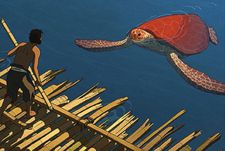 |
| Michaël Dudok de Wit: "In animation you stylize human emotions." |
In Michaël Dudok de Wit's quietly transformative The Red Turtle loneliness and delight meet remorse and the eternal return. As the director and I sat down for our conversation at the Sofitel hotel in midtown Manhattan the morning of the opening day of First Animation at the French Institute Alliance Française, storytelling was in the air.
Anne-Katrin Titze: Myths and fairy tales have been your main inspiration, you say?
Michaël Dudok de Wit: Yes, especially myths and as a child I read fairy tales voraciously. On and on and on. It was an obsession.
AKT: Any specific ones? Any favourites?
MDdW: Of course the Western European ones and when I ran out, when I read them all, I started exploring. From Indonesia, from Japan, a few from Africa.
AKT: And some of them found their way into The Red Turtle?
MDdW: Not literally. Have you seen the film?
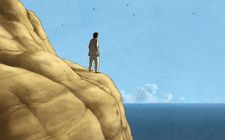 |
| On Studio Ghibli: "For the production of the film, for the development, I went there on a regular basis." |
AKT: Yes, of course!
MDdW: There's a metamorphosis; it's a common theme in many cultures.
AKT: I was thinking of the stories of seal maidens in particular.
MDdW: Yes!
AKT: I was reminded of that. You even have the hint to selkies with the dead seal early on. But it is not the seal maiden that transforms.
MDdW: Yes! You know what? While I was writing the storyboard, after I had written the script, then people talked to me about selkies or seal maidens. And then I did some research on that and discovered, my god, it's very close. It's not a direct inspiration when I was writing the script.
AKT: So it came after?
MDdW: Yeah, but by osmosis I must have absorbed it when I was younger. And the fact that there are seals in the film is not pointing towards the selkie myth, the seal maiden myth, it's something else.
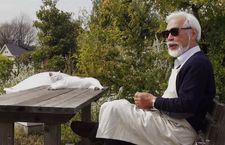 |
| Ushiko with Hayao Miyazaki in Mami Sunada's The Kingdom Of Dreams And Madness |
AKT: You collaborated with Studio Ghibli. When you went there, did you meet Ushiko?
Michaël looks at me, puzzled.
AKT: The cat?
MDdW: Oh, right. How do you know about Ushiko?
AKT: I thought about their [mascot] cat because I was walking past the Algonquin Hotel on my way here. And at the Algonquin they always have a cat that is a bit like Ushiko. Now, it's a new cat, replacing Matilda, named Hamlet VIII. Every time I'm on West 44th Street I check in on the cat. I know Ushiko from The Kingdom Of Dreams And Madness, the documentary on Studio Ghibli. Have you seen it?
MDdW: I have not seen it. Someone sent me a copy but it wasn't translated.
AKT: When you were there, did you meet Ushiko?
MDdW: No, I didn't. I'm surprised now that you mention it. I'll ask them next time.
AKT: Do you go there often?
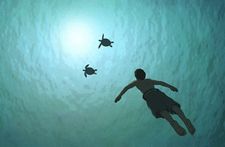 |
| On the lack of dialogue in The Red Turtle: "It's vulnerable. But somehow it gives the film its strength also." |
MDdW: For the production of the film, for the development, I went there on a regular basis. Literally, of course, to keep them informed about the progress, but literally, to get feedback. Isao Takahata was the main spokesperson. He is very cultured, very familiar with Western Europe. He speaks some French. He's very much into symbolism, metaphors and the subtle emotions. I talked a lot with him.
AKT: About the symbolism in The Red Turtle?
MDdW: Yes, yes. I think we never said this literally but I think both the Japanese and I wanted to rise above our cultural differences. It was not going to be a typically Japanese oriented film or a typical western film. It was hopefully going to be a film that works in both, just like their films work so well in many western countries.
AKT: Is that also why there is no spoken language?
MDdW: No, actually. There was some language. I really believed that the film needed some spoken language; just at some very important moments it needed a little bit of dialogue. But it didn't feel right and we took it out.
AKT: It's good. I think it works.
MDdW: I think it works, too. It's vulnerable. But somehow it gives the film its strength also.
 |
| CinéSalon Best Actress: A César-Winner Showdown at the French Institute Alliance Française Photo: Anne-Katrin Titze |
AKT: Where I most thought Ghibli was in the little animals, something about them. That is something of a specialty - you feel for the little crabs. In many of their films there are tiny sidekicks showing up somewhere. Totoro has some miniature things that are going on - there is always something else moving and alive. It's international.
MDdW: It's international, yes.
AKT: It makes you feel that even the smallest, tiniest thing counts.
MDdW: Yeah, there are different reasons. As you describe, also in animation you stylise human emotions. You simplify them because it's too complex to draw. In reality humans have a lot of emotions at the same time, in animation you can't convey that.
AKT: Fairy tales do the same.
MDdW: Exactly! So you compensate by externalizing emotions in creating little, as you said, sidekick creatures. The crabs were particularly important because they're cute but they're not so cute.
AKT: Oh no, they're not.
MDdW: I didn't want rabbits and squirrels and little singing birds, I wanted creatures that are fascinating but you don't want to touch them. The same with the main character, the Red Turtle. One of the characteristics of turtles is that they are reptiles. They have a fierce expression and that makes her more interesting. I mean, you see it elsewhere too. With Totoro also. Totoro is not that cute, the big Totoro. It has kind of a strange grin and that makes Totoro so much more interesting.
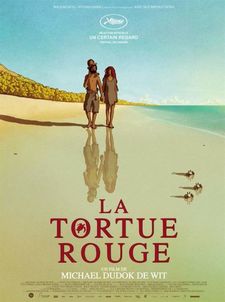 |
| La Tortue Rouge poster: "The crabs were particularly important because they're cute but they're not so cute." Photo: Anne-Katrin Titze |
AKT: Right! Because there always has to be something off, something threatening, something that is slightly disturbing - otherwise we don't remember it.
MDdW: Yes, oh I wish we could talk longer. I have to mention quickly - at the very beginning when we started and Studio Ghibli contacted me and I started writing, Takahata sent me a book. You probably know it. It's called Kwaidan by Lafcadio Hearn. The subtitle is Japanese Ghost Stories. It's basically fairy tales and ghost stories.
Takahata simply said "Have a look at this book! It may inspire you." I hadn't talked to them about desert island yet, we just started from scratch. I asked: "Do you mean you want me to take one of these stories?" He said "No, no just to get you a feeling of our culture." And yes, it was fascinating.
Coming up - Michaël Dudok de Wit on reading the original Robinson Crusoe, the reaction of Lady Chatterley director Pascale Ferran to the script for The Red Turtle, The Count Of Monte Cristo, and what is a "deep, deep, deep fear" for him.
Masterclasses coming up for Michaël Dudok de Wit include the International Animation Festival 'Anima' in Brussels on February 14 and in the UK at the University of Hertfordshire, Hatfield on February 28.
Best Actress: A César-Winner Showdown (co-curated by Pauline Conroy and Delphine Selles-Alvarez) concludes with an Audience Choice Award Screening on March 6.
The French Institute Alliance Française Animation First, co-curated by Delphine Selles-Alvarez and Catherine Lamairesse, ran from February 2 through February 4.
The 43rd César Awards will take place at the Salle Pleyel in Paris on March 2.





















